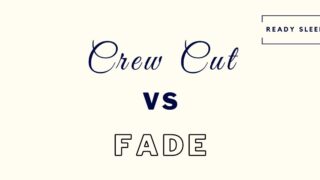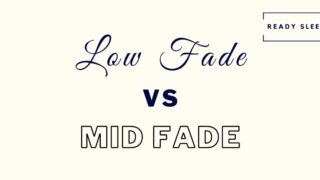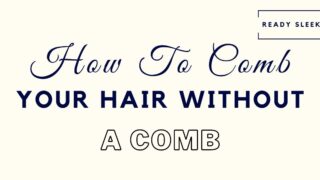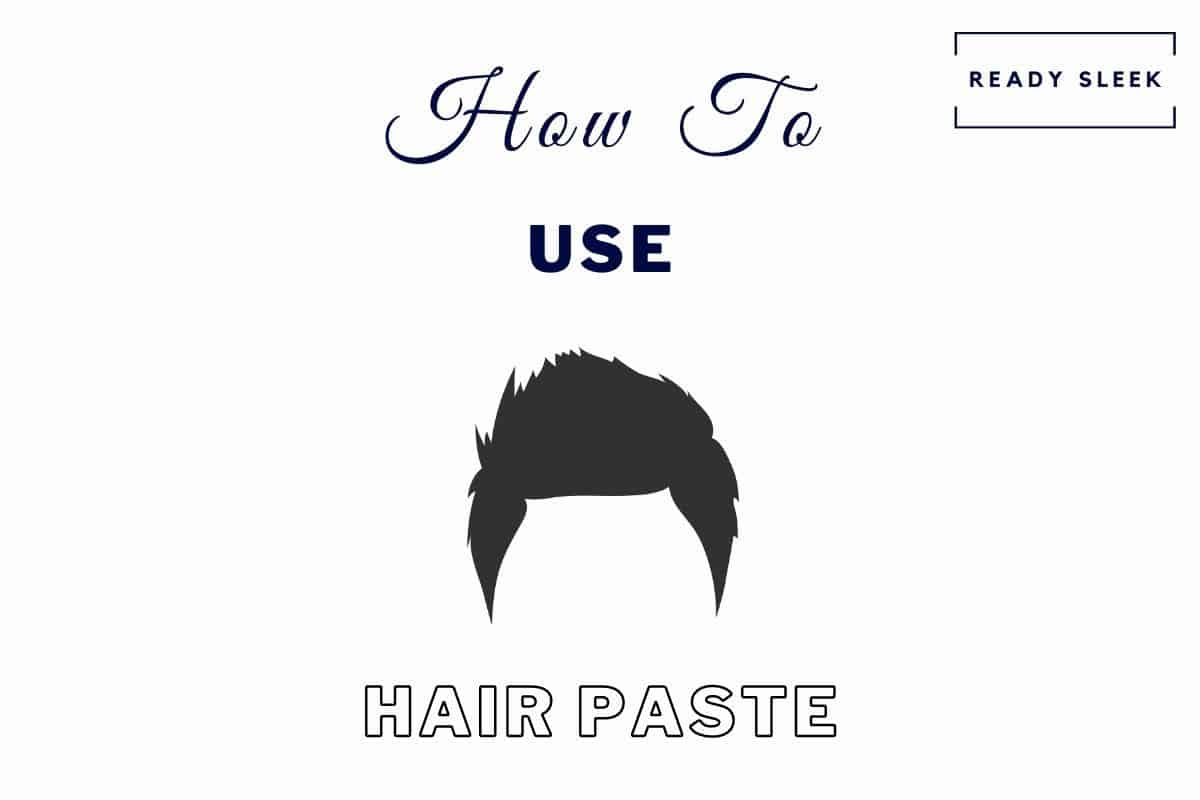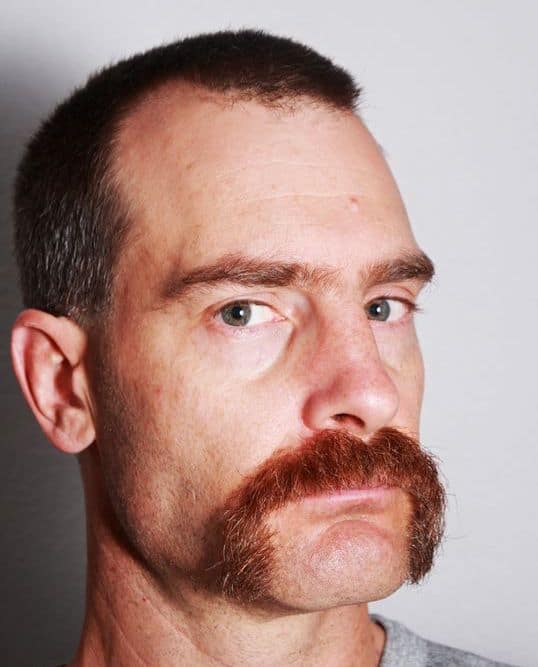These two styles have so many variations that it’s important to boil it down to the key points. So, what is the difference between a fade and a short back and sides?
A fade refers to the gradual and blended increase in length as you go up the sides and back. In contrast, a short back and sides haircut doesn’t have this gradual tapering and instead has most of the sides and back the same length.
Although that’s the gist, as always, I wanted to dig deeper.
It’s common for men to get these two confused and end up in disagreements with their barber.
That’s what we want to avoid.
After reading this, it’ll never happen to you. You’ll learn exactly what the differences between the two are, as well as how to choose between them.
Let’s get to it.
What Is A Fade?
The term “fade” refers to the blended, blurred effect that occurs as a result of a gradual transition in length from short to long.
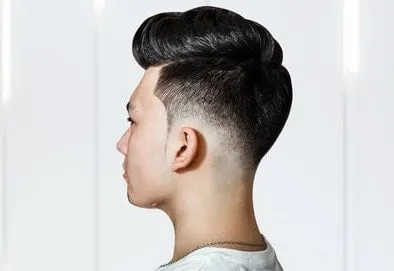
[From Shutterstock]
It’s done at the sides and back and is an extremely common feature of modern hairstyles.
The classic appearance of a fade is due to the blending of different lengths without any harsh lines.
But the term “fade” doesn’t mean much unless you know what type of fade you’re going for.
When asking for a fade you’ll need to specify two things: the transition point and the shortest length.
The transition point is how high you want the fade to be. In other words, this is the point where the shortest length of the sides and back starts to transition into longer lengths as you go up.
It can be a “high” fade – with the transition point high up near the temples. It could be a “low” fade – transitioning around an inch above the ear.
Alternatively, it could simply be a “mid” fade, transitioning somewhere in between these two points.
Now, the other thing you need to specify to your barber is how short you want the shortest length of the fade to be.
You could have this shaved all the way down to the skin – i.e a “skin fade”. Or you could have it a little longer at a #1 or a #2.
The choice is yours. It really depends on how obvious and eye-catching you want the fade to be. As you’d expect, the shorter the shortest length of the fade, the more obvious it’ll be.
What Is The Short Back And Sides?
The short back and sides is also known as a “regular haircut”. It’s a classic men’s hairstyle characterized by there being short hair at the back and sides with longer hair on top. The hair on top is usually long enough to comb.
The parting is sometimes defined.
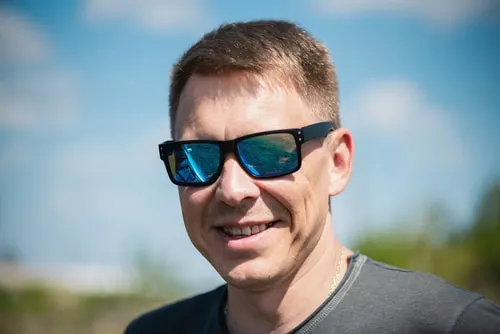
Caption – A short back and sides. Some slight tapering of the sides, but no obvious blended, blurred effect like you’d see with a fade.
However, although the hairstyle traditionally follows this formula, it’s often used to refer to any style with long hair on top and short hair at the sides and back.
I don’t completely agree with this use of the term. For example, technically a pompadour on top with short hair on the sides could technically be called a “short back and sides”.
But it would make much more sense to simply call it a “pompadour”.
Anyway, the point is, the short back and sides is a simple hairstyle where the top is longer than the sides and back which don’t have the tapering of length as a key feature.
It’s what you could usually expect from a barber and asked them for a “regular” haircut. Although it’s definitely advisable to give them more specific instructions than this, it’s probably what you expect to receive.
Fade Vs Short Back And Sides: Key Differences
Here are the key differences between the fade and the short back and sides summarised:
1. Tapering
This is the big one, as you’d expect.
The fade is a feature where there is a gradual tapering of length at the sides and back with no harsh lines and a blurred, blended appearance as a result.
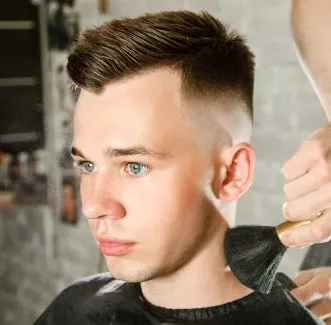
[From Shutterstock]
The short back and sides does not have tapering as a key feature and you don’t get this intricately blended effect at the sides and back.
That’s not to say there isn’t any tapering going on with the sides and back. Although you could have the sides and back the exact same length from the bottom to the top, you could also have a small amount of tapering.
For example, you could go from a #2 at the bottom to a #3 at the top of the sides/back.
But that distinctive blurred and blended appearance of the fade won’t be present. At the end of the day, that’s what makes a “fade” a “fade”.
2. Feature Vs Style
Ultimately, the “fade” is not a style – it’s a feature.
People often confuse this fact and simply turn up to the barber asking for a “fade”.
What I want you to take away from this is that the fade is a feature that can be incorporated into any style you could possibly think of.
For example, you could get a slick back with a fade, a pompadour with a fade, and so on.
The short back and sides, on the other hand, is a style.
It follows a formula and if you ask for a short back and sides from your barber it’ll probably be enough information. However, they’ll most likely want to know how short you want the sides and back.
They may also ask you how much you want to be taken off the top.
But if they’re following the traditional formula for the “short back and sides”, you’ll most likely end up with hair on top that’s long enough to comb over to the side with the parting relatively well-defined.
To sum that up – the fade is a feature and the short back and sides is a style.
Fade Vs Short Back And Sides: How To Choose
Now that you’ve gotten to grips with how these two are different, let’s discuss how to choose between them.
Essentially, consider the following factors:
1. Modern Vs Classic
Although “fades” have been around for decades in some shape or form, they’ve really taken the men’s hair world by storm in recent years.
The fade has become a staple service of barbershops globally and it’s become somewhat of an art form.
Barbers try to outdo each other with the quality of their fades – the cleanest, sharpest, or most outlandish.
Fades will always add a distinctly modern aesthetic to any hairstyle. It’s a great way to add a modern touch to traditional hairstyles like slick backs, comb overs, and pompadours.
The simple addition of a fade is an easy way to do that.
The short back and sides has a more classic and traditional appearance to it when compared with a fade.
Some men do prefer this over the modern fade.
It’s a battle between modern and classic. There’s a good chance you lean toward one more than the other.
2. Subtlety
The short back and sides is a better option for men who prefer a more understated and subtle hairstyle that doesn’t draw much attention.
At the same time, it’ll always be considered versatile, professional, and effortlessly neat and tidy.
Simple hairstyles are easier to maintain and require less energy in general.
You won’t need to worry about how clean or crisp a short back and sides looks as much as you would with a fade.
You know how to set your expectations.
It won’t be as attention-grabbing as a fade. This is because the blurred and blended appearance of the fade effect is interesting to look at.
It catches the eye, even if it’s just for a second. Of course, the more unique the fade is, the more attention-grabbing it’ll be.
In addition, the greater the contrast between the shortest length of the fade and the hair on top, the more attention it’ll draw as well.
For example, the contrast between the long and swept up hair of a pompadour on top with a clean and crisp skin fade at the sides and back is eye-catching.
It’s the contrast.
Ultimately, if you’d rather a more subtle hairstyle, avoid the fade and go for a simple short back and sides instead.
3. Face Shape
Both fades and the short back and sides can have a slimming effect on the face.
This is because it takes volume and fullness away from the sides.
It’s the main reason why they work so well for men with rounder faces – they tend to make them look narrower and work to define the jawline as well.
Ultimately, both of these options will work well in this respect. However, fades tend to have slightly more of a slimming effect on the face.
The higher the fade is, the more pronounced the effect will be.
The main reason for this is the tapering of length from very short at the bottom to long at the top.
What this does is draw the eyes diagonally downward, making the jawline look more chiseled as a result.
You can use the hair on top to accentuate this as well. For example, men with round faces can add length to the face by styling a quiff or pompadour on top.
In contrast, they will most likely find that shorter hairstyles such as buzz cuts simply make the face look even rounder.
To sum that all up, take face shape into consideration when choosing between a fade and a short back and sides.
Although both would be good options for men with round or less angular faces, a fade is usually an even better option than a regular short back and sides.
Especially considering you can potentially do more with the hair on top. A traditional short back and sides still has pretty short and scissor-cut hair on top.
Although it’s usually long enough to comb, there usually won’t be much hair to add a lot of height with.
Conclusion
Choosing between a regular, short back and sides and a faded style isn’t tough. Once you know how they’re different and what each of them can potentially do for you, it gets down to personal preference.
Enjoy.
Ready Sleek founder. Obsessed with casual style and the minimalist approach to building a highly functional wardrobe. Also a fan of classic, vintage hairstyles.

![Fade Vs Short Back And Sides: Differences [With Pics]](https://www.readysleek.com/wp-content/uploads/2021/06/fade-vs-short-back-and-sides-720x405.jpeg)
